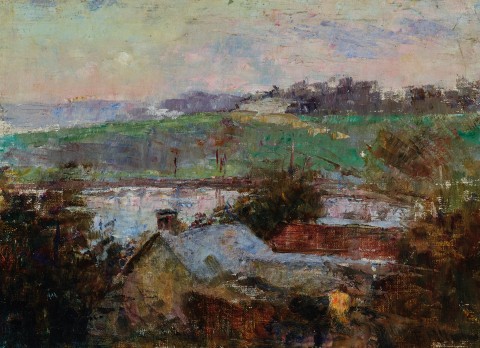KENSINGTON ROAD, SOUTH YARRA, c.1908
FREDERICK MCCUBBIN
oil on canvas board
25.5 x 35.5 cm
signed lower right: F McCubbin
letter of authenticity attached verso, signed by Louis McCubbin, dated 1 March 1946
Private collection
Christie’s, Melbourne, 24 November 1999, lot 6
Private collection, Sydney
We are grateful to Brenda Martin Thomas, wife of the late David Thomas AM, for kindly allowing us to reproduce David's research and writing in this catalogue entry.
Frederick McCubbin's move with his family to the rented property ‘Carlesberg’ in Kensington Road, South Yarra at the end of 1907 introduced some of the happiest and richest years in his art. Many of his finest paintings belong to this time – Winter Sunlight, 1908, in the collection of the Art Gallery of South Australia, Moonrise, 1909 in the National Gallery of Victoria, and Golden Sunlight, 1914, gifted to the Castlemaine Art Gallery and Historical Museum by Dame Nellie Melba, being among the best.
Having just returned from his first and only trip to England and the Continent, McCubbin’s practice was characterised by a lighter palette and a much looser application of paint, reflecting the liberating, painterly influence of his artistic mentor Romanticist J. M. W. Turner, as well as Corot, Monet and his English contemporary, George Clausen. That influence can be seen in these wonderfully atmospheric paintings such as the present Kensington Road, South Yarra, c.1908 which, each in their different ways dazzlingly colourful masterpieces, capture the feelings he expressed in a letter to his old friend Tom Roberts: ‘This is the loveliest place I have ever lived in. A charming old colonial house’ perched right over the Yarra with three acres of garden and trees... The winding stream, gums, osiers and wattle; interspersed. The night effects; sunrise, moonrise, we can see every way.’1 The old garden led to a paddock, which ran down to the Misses Armytage’s Como estate. The views over the Yarra were spectacular, whether towards Richmond as in The Coming of Spring, 1912, or the even more panoramic Flood Waters (also known as Rainbow over the Yarra), 1913 – both in the collection of the National Gallery of Australia, Canberra. A rainbow sometimes appeared in these later South Yarra views, a phenomenon of beauty and a metaphor of harmony. They had their genesis in numerous smaller sketches, spontaneous responses captured with a breadth of technique that gives them their special feeling of freedom and atmospheric delight.
Although McCubbin is principally known for large scale paintings which depict subjects drawn from Australian pioneering life, he considered his smaller, later works a significant aspect of his art. As Anne Gray, Curator of the National Gallery of Australia’s exhibition McCubbin: Last Impressions elaborates, ‘McCubbin’s art was most remarkable during his final years. The late McCubbin is one of the top 10 artists in Australia. His daring, his experimental painterliness, and his ability to capture the Australian landscape produced some incredible work.’2
1. McCubbin to Roberts, December 1907, Letters to Tom Roberts, vol. II, Mitchell Library, State Library of New South Wales, Sydney
2. Anne Gray cited in Perkin, C., ‘Such Dreams of Colour’, Weekend Australian, 8 – 9 August 2009, p.4
